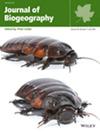Phylogenetic Insights Into Canidae Trait Variation Across Continents
Abstract
Aim
Understanding the spatial structuring of ecological communities involves considering the interplay between evolutionary history and environmental factors. This study investigates how the phylogenetic structure of Canidae influences the geographical distribution and trait patterns of lineages globally, and how these patterns relate to Bergmann's and Rapoport's rules.
Location
Americas, Africa, Eurasia.
Time Period
12 million years ago—present.
Major Taxa Studied
Canidae.
Methods
Using distribution data and phylogenetic information for 37 Canidae species, we analysed key ecological, functional and evolutionary variables. We applied phylogenetic fuzzy-weighting via principal coordinates of phylogenetic structure (PCPS) and variance partitioning analysis (VPA) to assess the contributions of phylogenetic structure and environmental factors to trait variation among species.
Results
Our results revealed distinct global patterns in body size, body weight, range size, habitat use and evolutionary distinctiveness among lineages. We also identified the shared contributions of phylogenetic structure and temperature to trait variation using variance partitioning analysis. The PCPS axes highlighted the influence of phylogenetic relationships on Canidae assemblages, particularly in South America.
Main Conclusions
Importantly, the study challenges the applicability of Bergmann's and Rapoport's rules across continents. The unique diversification history of Canidae in South America and Africa and their diverse environmental conditions likely contribute to the observed trait patterns that make both continents so distinguished when compared to North America and Eurasia. Our findings underscore the need to incorporate phylogenetic information in models assessing trait variation across geographic scales for unbiased estimates.

 求助内容:
求助内容: 应助结果提醒方式:
应助结果提醒方式:


